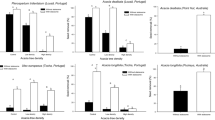Abstract
Ants are the only group of invertebrates currently identified as significant dispersers of seeds, but we report here the dispersal of Eucalyptus torelliana seeds by bees. Fruits of E. torelliana produce resin which is collected by workers of the stingless bee Trigona carbonaria. Seeds adhere to resin in the workers' corbiculate and are transported to the nest. Workers transported seeds distances of more than 300 m from the parent tree and seeds at the nest were viable and capable of germination. Seeds were removed from the nests by workers and discarded away from the nest, and E. torelliana trees became established in the vicinity of colonies of T. carbonaria. ‘Mellitochory’ may be a novel method of seed dispersal where bees are dispersers, and associated with fruits that produce resin as an attractant for bees.
Similar content being viewed by others
References
Andersen AN (1987) Effects of seed predation by ants on seedling densities at a woodland site in SE Australia. Oikos 48: 171–174
Andersen AN, Ashton DH (1985) Rates of seed removal by ants at heath and woodland sites in southeastern Australia. Aust J Ecol 10: 381–390
Armbruster WS (1984) The role of resin in angiosperm pollination: ecological and chemical considerations. Am J Bot 71: 1149–1160
Ashton DH (1979) Seed harvesting by ants in forests of Eucalyptus regnans E. Muell. in central Victoria. Aust J Ecol 4: 265–277
Barber HN (1965) Selection in natural populations. Heredity 20: 551–572
Boland DJ (1976) Dehiscence in Eucalyptus torelliana F. Muell. fruit. Aust Seed Sci News 2: 11–13
Boland DJ, Brooker MIH, Turnbull JW (1980) Eucalyptus Seed. CSIRO, Australia, pp 119–131, 170
Carr DJ, Carr SGM (1987) Eucalyptus. II. The rubber cuticle, and other studies of the Corumbosae. Phytoglyph Press, Canberra, pp 90–91
Cremer KW (1966) Dissemination of seed from Eucalyptus regnans. Aust For 30: 33–37
Cremer KW (1977) Distance of seed dispersal in eucalypts estimated from seed weights. Aust For Res 7: 225–228
Drake WE (1981) Ant-seed interaction in dry sclerophyll forest on North Stradbroke Island, Queensland. Aust J Bot 29: 293–309
Garcia MVB, Oliveira ML de, Campos LA de O (1992) Use of seeds of Coussapoa asperifolia magnifolia (Cecropiaceae) by stingless bees in the central Amazonian forest (Hymenoptera: Apidae: Meliponinae). Entomol Gen 17: 255–258
Heard TA (1988) Propagation of hives of Trigona carbonaria Smith (Hymenoptera: Apidae). J Aust Entomol Soc 27: 303–304
Heard TA, Hendrikz JK (1993) Factors influencing flight activity of colonies of the stingless bee Trigona carbonaria (Hymenoptera: Apidae). Aust J Zool 41: 343–353
Howard JJ (1985) Observations on resin collecting by six interacting species of stingless bees (Apidae: Meliponinae). J Kans Entomol Soc 58: 337–345
Howe HF, Smallwood J (1982) Ecology of seed dispersal. Annu Rev Ecol Syst 13: 201–228
Michener CD (1961) Observations on the nests and behaviour of Trigona in Australia and New Guinea (Hymenoptera, Apidae). Am Mus Novitates 2026: 1–46
O'Dowd DJ, Gill AM (1984) Predator satiation and site alteration: mass reproduction of alpine ash (Eucalyptus delegatensis) following fire in southeastern Australia. Ecology 65: 1052–1066
Ornduff R (1991) Size classes, reproductive behaviour and insect associates of Cycas media (Cycadaceae). Bot Gaz 152: 203–207
Pijl L van der (1982) Principles of dispersal in higher plants. Springer, Berlin Heidelberg New York, pp 22–23
Roubik DW (1982) Obligate necrophagy in a social bee. Science 217: 1059–1060
Roubik DW (1983) Nest and colony characteristics of stingless bees from Panama (Hymenoptera: Apidae). J Kans Entomol Soc 56: 217–222
Roubik DW (1989) Ecology and natural history of tropical bees. Cambridge University Press, Cambridge, UK, pp 28–29 161–206
Sakagami SF (1982) Stingless bees. In: Hermann HR (ed) Social insects, vol III. Academic Press, Sydney, pp 361–423
Stanley TD, Ross EM (1986) Flora of South-eastern Queensland, vol 2. Queensland Department of Primary Industries, Brisbane, pp 160–162
Wellington AB, Noble IR (1984) Seed dynamics and factors limiting recruitment of the mallee Eucalyptus incrassata in semiarid south-eastern Australia. J Ecol 73: 657–666
Wille A (1983) Biology of the stingless bee. Annu Rev Entomol 28: 41–64
Wille A, Michener CD (1973) The nest architecture of stingless bees with special reference to those of Costa Rica. Rev Biol Trop 21: 1–278
Author information
Authors and Affiliations
Rights and permissions
About this article
Cite this article
Wallace, H.M., Trueman, S.J. Dispersal of Eucalyptus torelliana seeds by the resin-collecting stingless bee, Trigona carbonaria . Oecologia 104, 12–16 (1995). https://doi.org/10.1007/BF00365556
Received:
Accepted:
Issue Date:
DOI: https://doi.org/10.1007/BF00365556




